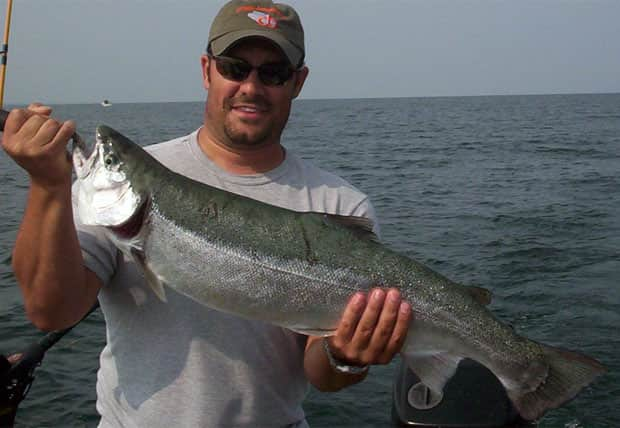Use Cheaters to Help Increase Your Trout and Salmon Success
Fishhound 11.14.12

Editor’s note: This blog installment comes from Fishhound pro staffer Capt. Lou Borrelli, who operates Get The Net Charters out of Rochester, N.Y.
In August 2011, the New York State DEC increased the allowable number of fishing rods per person from two to three (on the Great Lakes). The change was beneficial to anglers and captains, because it allowed us to run more rods with fewer people on deck.
Prior to the rules change, anglers on the Great Lakes needed to use cheaters, instead of an additional rod, to increase the number of lures in the water. Now, cheaters are often more of an option–but an important one, especially for boats with fewer anglers and/or equipment.
In this article, I’ll explain how to rig a fixed cheater. By fixed, I mean a cheater that’s held in place at a specific depth on the main line.
How to Build a Fixed Cheater
A fixed cheater is really nothing more than a short, three- to four-foot leader with high-quality snap-swivels at both ends. In between the swivels is a small pinch-pad release (I like to use the Offshore Tackle brand releases).
To build a fixed cheater, simply cut a 15- to 20-pound fluorocarbon leader. Attach a swivel to one end. Slide the pinch pad release onto the line, then tie a second swivel at the other end. Make up a few of these at home so they’re ready to go when needed in the boat.
How to Set a Fixed Cheater
First, set up your main line and downrigger as usual, and drop the main line about 10 feet into the water.
Next, attach a lure to one of the snap-swivels on your cheater.
Then, with the main line under tension, attach your cheater to the main line using the other snap-swivel.
Lastly, clip the cheater release onto the main line. Check that the cheater isn’t wrapped around the main line and lower the downrigger slowly. As the main line descends, the cheater will also lower into the water.
Stop your downrigger ball at the desired depth and two lures will be running on the same line.
In the example above, the cheater lure runs 10 feet above the main lure. Depending on the conditions, you may want to run the cheater lure from 5 to 35 feet above the main lure.
When a fish strikes, the release will let go and the cheater will slide down to the main line toward the downrigger ball. When this happens, the rod will pop straight up. It’s critical that you grab the rod and begin to reel as quickly as you can. Once the rod’s under tension, fight the fish as you normally would.
A fixed cheater allows you to cover more water, offer a different lure presentation and possibly target different species of fish. For example, if your main-line lure’s in 42-degree water (the preferred king-salmon temperature), you can run the fixed cheater in warmer water for steelhead or browns.
In some cases you may even catch two fish at the same time. When that happens, hold on: Trying to fight two powerful fish that are surging in different directions isn’t easy.
Make cheaters a part of your everyday trolling dynamic and you’ll increase your chances of catching Great Lakes salmon and trout.
For more information on this subject, feel free to contact me at the address below.


